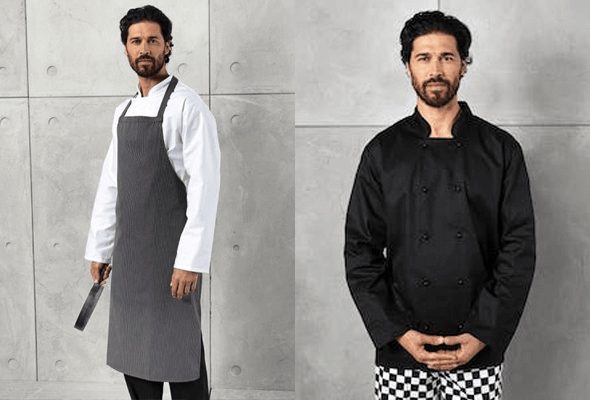The culinary world is not only a melting pot of flavors but also a canvas where tradition, innovation, and style converge. One aspect that vividly illustrates this amalgamation is the evolution of chef uniforms. Over the years, these iconic outfits have transcended their functional origins, transforming from traditional attire to trendy ensembles that reflect the changing landscape of the culinary industry. This journey through time unveils not only the historical roots of chef uniforms but also the modern trends and innovative designs that have shaped their contemporary identity.
Traditional Attire: A Glimpse into Culinary History
The genesis of modern chef uniforms can be traced back to the 19th century, with the pioneering efforts of Marie-Antoine Carême, a visionary French chef often hailed as one of the first celebrity chefs. Carême revolutionized the culinary world not only with his gastronomic expertise but also with his sartorial choices. He introduced the iconic white double-breasted jacket and the traditional toque, or chef’s hat, both of which have become emblematic of the chef’s attire.
The all-white ensemble served a dual purpose. Firstly, it was a practical choice, as white easily showcased cleanliness, prompting chefs to maintain a high standard of hygiene in the kitchen. Secondly, the double-breasted design allowed chefs to hide stains by simply reversing the jacket—a clever solution to the inevitable spills and splatters that occur in a bustling kitchen.
2. Functionality and Hygiene: The Driving Forces of Evolution
As kitchens evolved and professionalized, so did the chef uniform. The emphasis on functionality and hygiene led to the incorporation of various elements that addressed the practical needs of culinary professionals. Chef pants, in addition to adding a touch of style, proved to be practical as the pattern helped conceal stains and spills—a feature particularly important in the fast-paced environment of a busy kitchen.
Aprons, initially introduced as a utilitarian accessory, became a standard part of the chef’s ensemble. They not only protected chefs from spills and splatters but also provided additional storage for essential tools, enhancing the efficiency of the culinary workspace.
Moreover, the evolution of chef uniforms responded to the physical demands of working in a hot and demanding environment. Fabrics became more breathable, cuts more comfortable, and materials lighter, ensuring that chefs could navigate their workspace with ease during long and arduous hours.
3. Modern Trends: Personalization and Diversity
In recent decades, a significant shift has occurred in the world of chef uniforms—a move towards modernization and personalization. Chefs and culinary professionals are now embracing a more individualistic approach to their attire, moving away from the one-size-fits-all mentality of the past.
Many contemporary chefs opt for customized uniforms that not only reflect their personal style but also communicate the identity of their restaurants. The traditional all-white palette is no longer sacrosanct, as chefs experiment with a spectrum of colors and patterns, injecting a sense of personality into their uniforms.
The exploration of different cuts and styles has become a trend in itself. Chefs are seeking a delicate balance between comfort and aesthetics, recognizing that a well-designed uniform not only enhances the visual appeal of the kitchen staff but also contributes to their overall well-being and performance.
4. Innovations in Design: Where Technology Meets Tradition
Advancements in technology have played a pivotal role in reshaping chef uniforms. Fabrics with moisture-wicking and anti-microbial properties are now common, addressing the challenges posed by the intense heat and potential exposure to foodborne pathogens. These innovations not only contribute to the comfort of the chefs but also play a crucial role in maintaining a hygienic kitchen environment.
The introduction of stretch fabrics has further revolutionized the design of chef uniforms. These materials provide chefs with greater flexibility and freedom of movement, a crucial factor in an environment where precision and agility are paramount. The incorporation of these fabrics aligns with the evolving nature of the culinary profession, where chefs are not only cooks but also performers in a high-stakes culinary theater.
Additionally, sustainability has become a focal point in the design of modern chef uniforms. Many chefs and establishments are opting for eco-friendly materials and designs that prioritize longevity and durability. This shift towards sustainability aligns with the broader global movement towards responsible and ethical practices in various industries.
5. Cultural Influences: A Global Tapestry of Styles
Chef uniforms are not immune to the influences of cultural and global trends. As culinary traditions from different corners of the world intermingle, chefs often incorporate elements of their heritage into their uniforms. This fusion of styles creates a rich tapestry of diversity, where each uniform becomes a unique reflection of the chef’s background and the globalized nature of contemporary cuisine.
In conclusion, the evolution of chef uniforms encapsulates the dynamic interplay between tradition and innovation. From the classic white double-breasted jacket to the diverse and personalized uniforms of today, each iteration reflects not only the functional needs of the culinary profession but also the changing aesthetics and values of society. As chefs continue to push boundaries in the kitchen, their uniforms serve as both a nod to tradition and a canvas for creative expression in the modern culinary landscape. The journey from traditional to trendy is a testament to the resilience and adaptability of an industry that is, quite literally, always in the heat of the moment.

